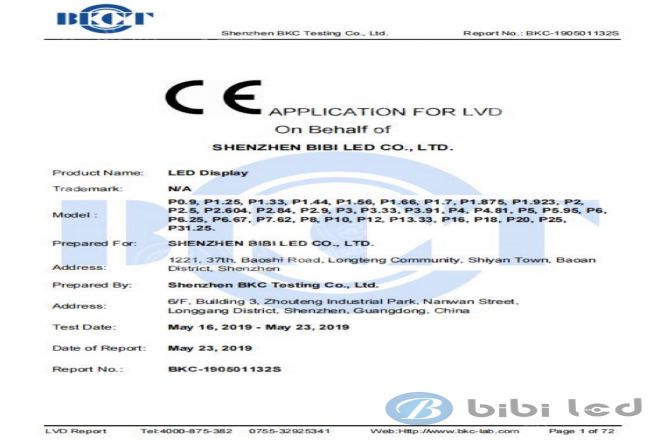Introduction

In the LED display industry, safety certification is an important link to ensure product quality and meet market access requirements. Among them, UL certification and CE certification are two major certification systems that have attracted much attention. These two certification systems not only provide quality assurance for LED display manufacturers but also enhance consumers’ confidence in the products.
Therefore, it is of great significance to understand and master the UL and CE certification knowledge of LED display screens to promote the development of the industry, improve product quality, and enhance market competitiveness.
This article will analyze the UL and CE certification of LED displays in detail.
1. What is LED display UL certification?
LED display UL certification, in short, means that LED display products have passed a comprehensive safety inspection and evaluation conducted by an authoritative third-party organization, Underwriters Laboratories (UL).
This certification mark is like a “safety passport” of the product, which proves that the LED display is safe and reliable in electrical, fireproof, and mechanical aspects.
So, how exactly does UL certification work? First of all, UL will conduct a series of strict tests on the LED display to check whether its circuit is safe, whether it will catch fire, and whether its mechanical structure is stable. These tests are used to ensure that the LED display does not cause any harm or danger to users during use.
In addition to testing, UL will also check the design and manufacturing process of LED displays to see if they meet a series of standards and specifications. This is like developing a “code of conduct” for the LED display so that it can function better and ensure the stability of the display effect.
LED display products with UL certification will be more competitive in the market. Because when consumers see the UL logo, they will trust the product more and feel that it is safer and more reliable. This is undoubtedly a good selling point for LED display manufacturers, as it can attract more consumers.
2. What is LED display CE certification?

LED display CE certification refers to the process of obtaining the CE mark through relevant testing and verification of LED display products that meet the requirements of European directives.
The CE mark is regarded as a “passport” opened by the manufacturer and entered the European market, indicating that the product has met the safety requirements stipulated in the EU directives.
Specifically, CE certification mainly focuses on product safety, environmental protection, and health. During the CE certification process of the LED display, the certification body will conduct a series of tests on the product, including the evaluation of electromagnetic compatibility (EMC) and low voltage instruction (LVD).
These tests are designed to ensure that the product does not cause harm to users during use and complies with relevant regulations and standards in the European market.
CE-certified LED display products can be sold in EU member states without having to meet the requirements of each member state, thus realizing the free circulation of goods within EU member states.
This not only provides manufacturers with a broader market space but also reduces the risk of products being sold in the European market.
Therefore, it is very important for LED display manufacturers who want to enter the European market to obtain CE certification. It can not only improve the competitiveness of products but also increase consumers’ trust in products.
At the same time, CE certification is also an important means to protect the rights and interests of consumers and ensure that the products they buy are safe and reliable.
It should be noted that CE certification must be carried out by an announcement agency authorized by the European Union to ensure its validity and authority.
When applying for CE certification, manufacturers need to follow the relevant procedures and requirements and provide the necessary technical documents and test reports to prove that the product meets the standards and requirements of CE certification.
3. Why is certification important for LED displays?
The importance of certification for LED displays is mainly reflected in the following aspects:
First of all, certification is a key means to ensure product quality and safety. As a high-tech product, the quality and safety of LED displays are directly related to the user experience and trust.
Through UL, CE, and other certifications, it can ensure that the LED display screen meets the relevant standards and requirements in terms of electrical safety, fireproof performance, electromagnetic compatibility, etc., so as to protect the safety rights and interests of users.
Secondly, certification helps to improve the competitiveness of products. In today’s fierce competition in the market, LED display products with certification marks are easier to gain the trust and recognition of consumers. This can not only improve product sales and market share but also establish a good brand image and reputation for enterprises.
In addition, certification is also an important condition for enterprises to explore the international market. Different countries and regions have different safety and quality requirements for imported products, and only products that meet the relevant certification standards can successfully enter these markets.
Therefore, through UL, CE, and other certifications, LED display manufacturers can open up broader sales channels for their products in the international market.
Finally, certification can also promote the healthy development of the LED display industry. By formulating and implementing certification standards, the market order can be standardized, the emergence of unqualified products can be reduced, and the image and reputation of the whole industry can be improved.
At the same time, certification can also promote enterprises to carry out technological innovation and product upgrading and improve the technical level and competitiveness of the whole industry.
4. What is the difference between LED display UL and CE certification?

Although the UL certification and CE certification of LED displays are to ensure the safety and quality of products, they are obviously different in many aspects. Next, I will try my best to explain the difference between these two certifications in a simple and easy-to-understand way.
First of all, they come from different places. UL certification is issued by a certification body in the United States, which is mainly concerned with whether the product meets the safety standards in the United States and Canada. CE certification is a European certification mark, indicating that the product has met the requirements of the European safety directive.
Secondly, their certification process and requirements are also different. For example, when applying for UL certification, the manufacturer needs to submit a lot of detailed information about the product, including its structure, components, materials, etc., and then the UL certification body will conduct a comprehensive inspection and test of this information.
CE certification requires the manufacturer to prepare some certification documents and then test the product to ensure that the product meets Europe’s safety, environmental protection, and health requirements.
Let’s talk about the cost and time. Because the standards and processes of the two certifications are different, their cost and time may also be different. Generally speaking, the cost of CE certification may be lower, but some specific categories of products may require a longer certification time.
The cost of UL certification may be slightly higher, but its certification process is usually more efficient, so the time may be relatively short.
Finally, the influence of these two certifications in the market is also different. If your product wants to enter the U.S. or Canadian market, then UL certification is very important. And if your product wants to enter the European market, CE certification is essential.
Therefore, in short, UL certification and CE certification are to ensure the safety and quality of LED display screens, but they come from different places, have different certification processes and requirements, and are suitable for different markets.
When applying for certification, manufacturers need to choose the appropriate certification according to their product characteristics and target market.
5. Do all LED displays require UL and CE certification?
Not all LED displays require UL and CE certification. These two certifications have different scopes of application and certification requirements.
UL certification is mainly aimed at the North American market, especially in the United States and Canada. If the LED display is planned to be sold in these regions, UL certification is very necessary.
UL certification focuses on the electrical safety and fireproof performance of the product to ensure that the product will not cause harm to users during use.
CE certification is mainly applicable to the European market. It said that the product meets the requirements of the European safety directive to ensure that the product meets the relevant safety and environmental standards when sold in Europe. Therefore, if the target market of LED displays is Europe, CE certification is necessary.
It should be noted that in addition to UL and CE certification, some other countries and regions may have their own certification requirements. Therefore, when deciding whether to certify, manufacturers should determine which certifications are required according to the target market of the product.
6. How do consumers verify whether the LED display has passed UL or CE certification?
Consumers can verify whether the LED display has passed UL or CE certification in the following ways:
- Find the certification mark:
First of all, consumers can observe whether there is a UL or CE certification mark on the LED display product or its packaging. These marks are issued by the certification body, indicating that the product has passed the corresponding certification process.
- Check the website of the certification body:
Consumers can visit the official website of the UL or CE certification body, enter the product model or manufacturer information on the website, and check whether the product has passed the certification. The certification body’s website usually provides a detailed certification information query service.
- View the certification certificate:
If possible, consumers can ask the manufacturer or seller to provide the UL or CE certification certificate of the LED display. These certificates are official documents issued by the certification body, which can prove that the product has passed the certification.
- Consulting professionals:
Consumers can also consult relevant professionals, such as electrical engineers or product safety experts, for professional advice on whether the LED display has passed UL or CE certification.
It should be noted that when purchasing LED display screens, in addition to the certification situation, consumers should also consider the performance, price, after-sales service, and other factors of the product and choose products and manufacturers with good reputations and reliable quality.
At the same time, if consumers have any questions about the product’s certification, they can consult the manufacturer or seller in time and ask for relevant supporting documents.
7. How do consumers distinguish between genuine and counterfeit products with UL and CE certification marks on the LED display?

Consumers can identify whether the UL and CE certification marks on the LED display are genuine through the following methods and avoid buying counterfeit products:
1). Check the integrity of the certification mark
Logo clarity: Genuine UL and CE certification marks are usually clearly printed with clear lines, while the logos of counterfeit products are often printed vaguely, with double shadows or uneven colors.
Logo integrity: The genuine certification logo usually contains the name of the certification body, the certification code, the product category, and other information. Consumers should carefully check whether the information is complete and accurate.
2). Check the website of the certification body
Enter product model or manufacturer information: Consumers can visit the official website of the UL or CE certification body, enter the product model or manufacturer information of the LED display, and check whether the product has really been certified.
Compare the certification information: The certification information found on the website should be consistent with the certification mark on the product, including the certification code, product description, etc.
3). Observe the details of the product
Product quality: Genuine LED display screens are usually well-crafted and neat in appearance, while counterfeit products may have problems such as appearance defects and rough materials.
Packaging and accessories: The packaging and accessories of genuine products are usually carefully designed, which is obviously different from counterfeit products. Consumers can pay attention to checking whether the product packaging, instructions, and other accessories are complete and standardized.
4). Consult a professional or seller
Consulting professionals: Consumers can consult electrical engineers or product safety experts to understand the authenticity identification method of LED display certification marks.
Ask the seller: Consumers can ask the seller for the certification certificate or relevant supporting documents of the product to further verify the authenticity of the product.
5). Beware of low-price traps
Reasonable price: When buying an LED display, consumers should pay attention to whether the price is reasonable. If the price of the product is much lower than the market price, there may be quality or certification problems, and consumers should buy it cautiously.
Conclusion
In short, UL and CE certification are an indispensable and important part of the LED display industry. They provide a strong guarantee for product quality and safety and also open up a broader market space for manufacturers.
Finally, if you want to know more about LED displays, please contact us.
